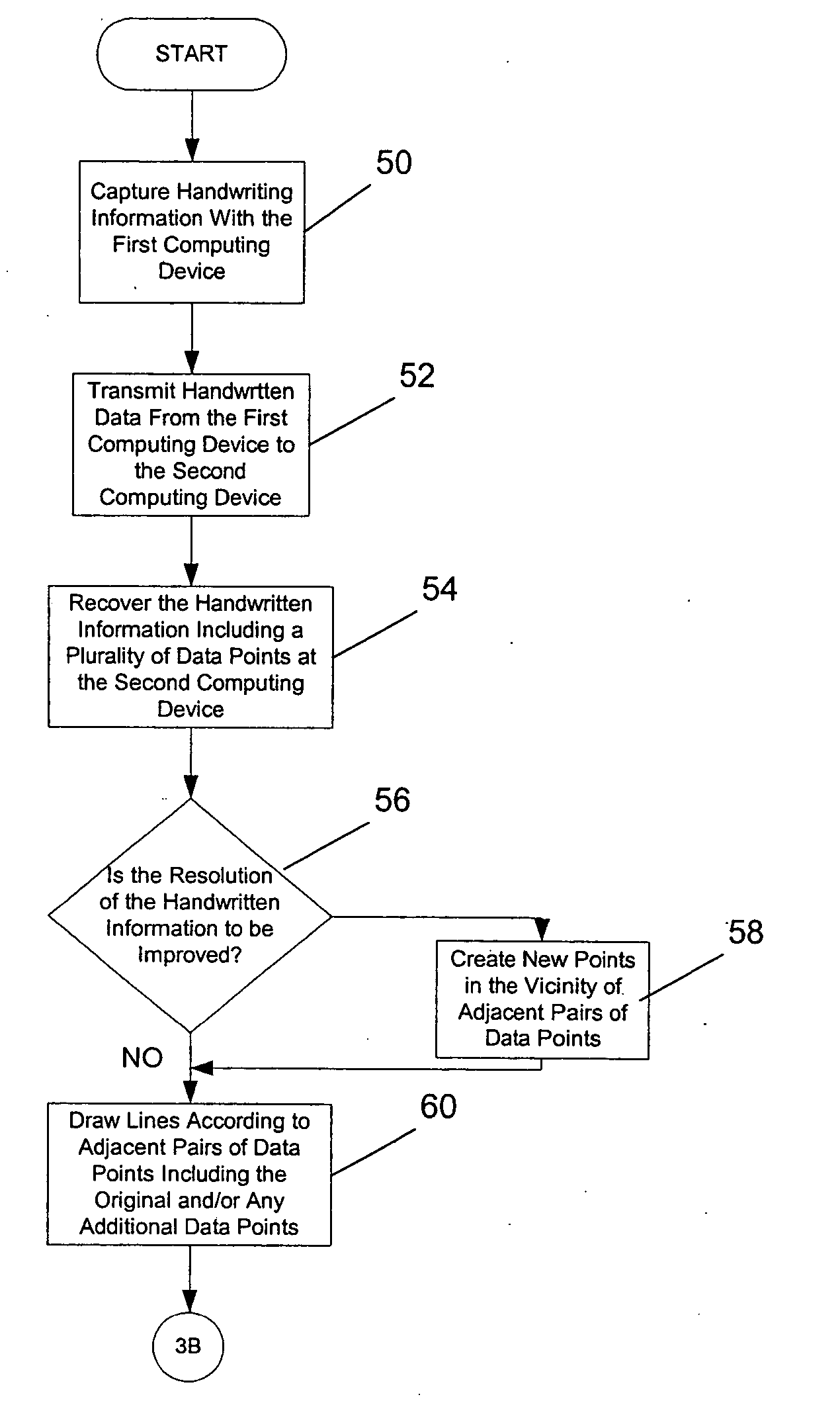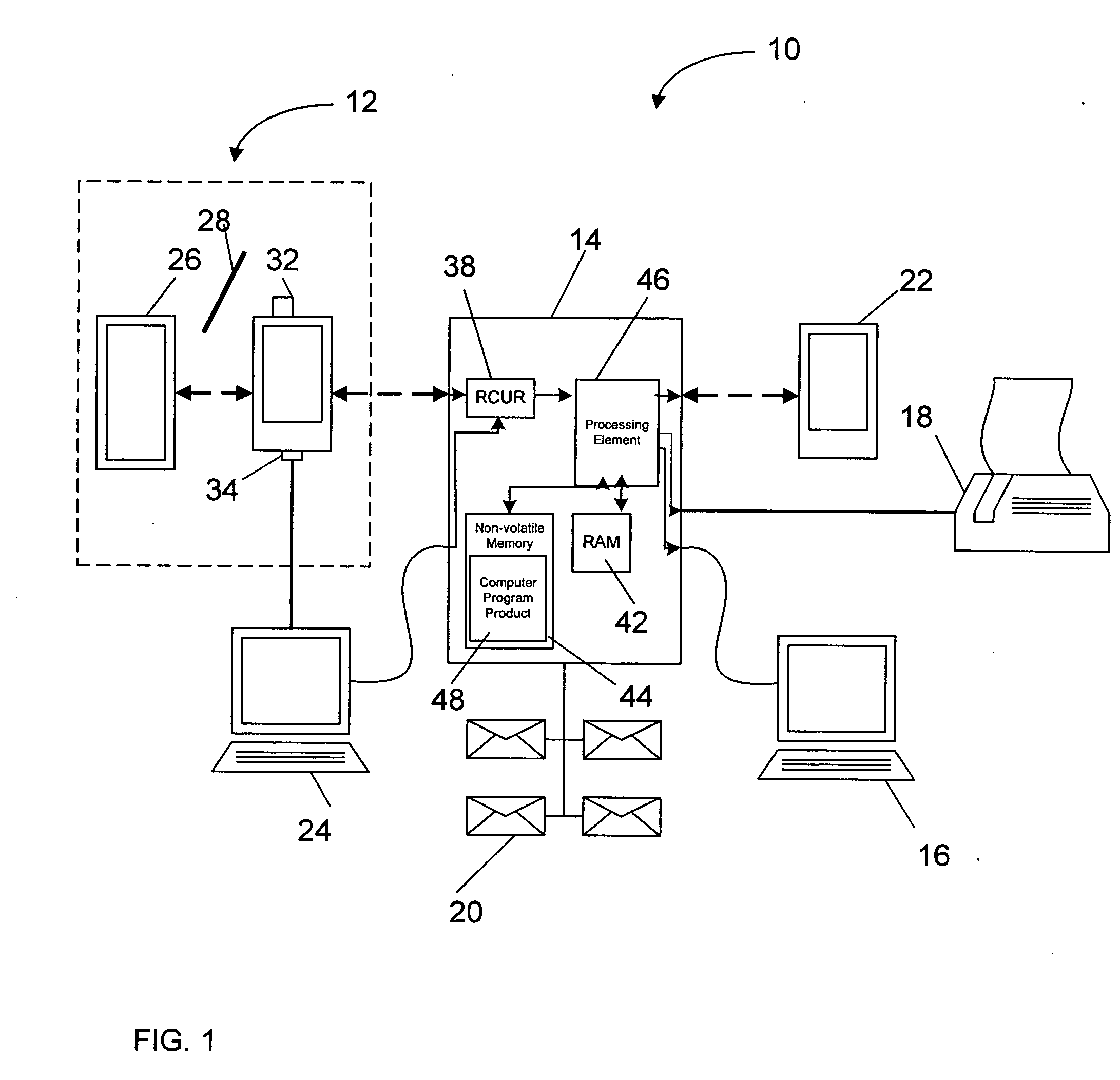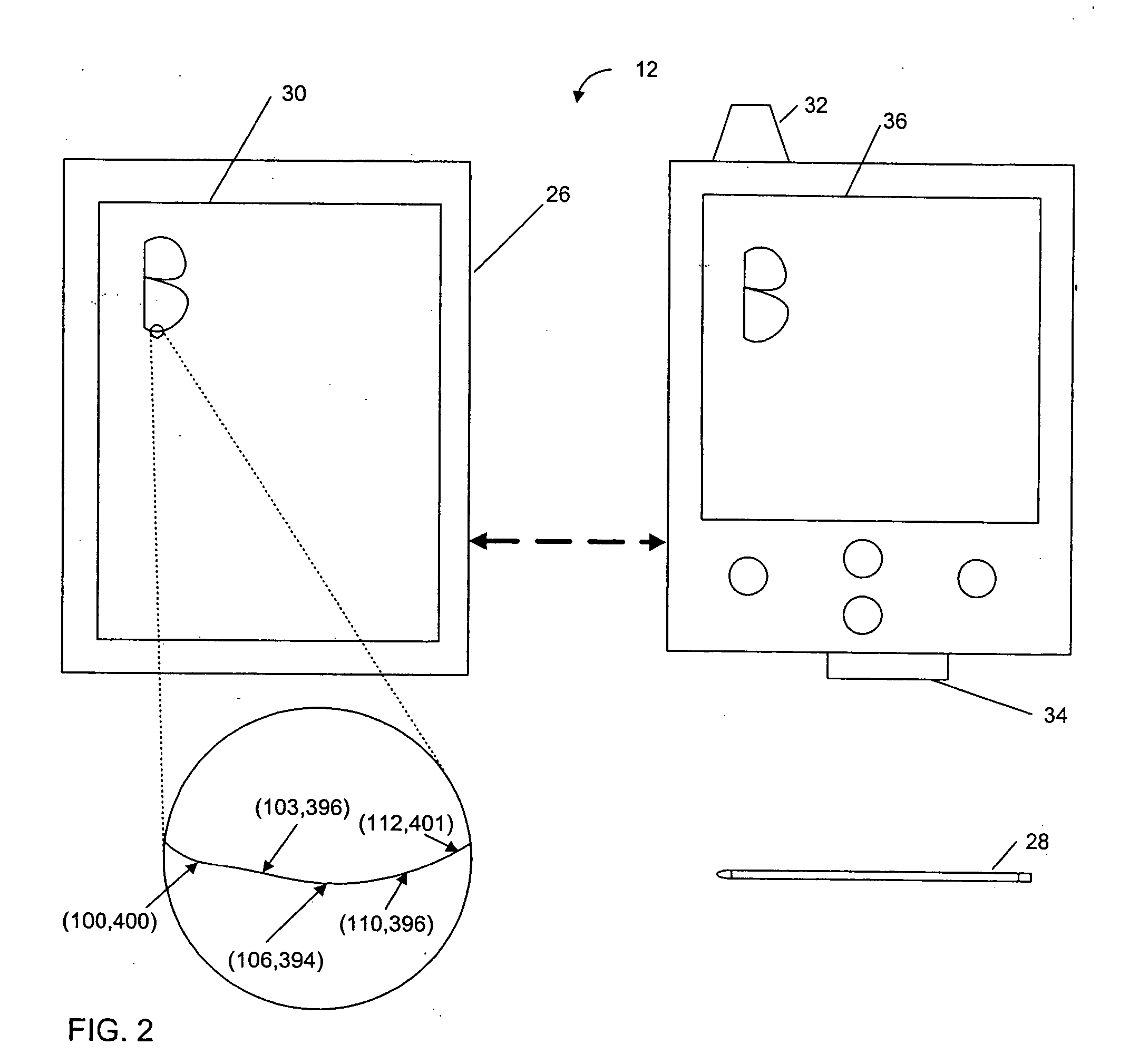[0012] The present invention therefore provides improved systems, computer program products and methods for transmitting and processing handwritten data in a manner that offers increased functionality by reducing the processing, memory and communications bandwidth requirements of the first computing device that captures the handwritten information. According to one aspect of the present invention, a system, computer program product and method are provided that smooth the handwritten information following the transmission of the handwritten data to a second computing device, thereby reducing the memory, processing, and communications bandwidth requirements of the first computing device. Similarly, according to another aspect of the present invention, a system, computer program product and method are provided for creating new points in the vicinity of at least some of the data points that comprise the handwritten information following the transmission of the handwritten data to a second computing device, thereby improving the resolution of the handwritten information without increasing the memory, processing and communications bandwidth requirements of the first computing device. According to yet another aspect of the present invention, a system, computer program product and method are provided that associate additional data with the handwritten information after the handwritten information has been transmitted from the first computing device that captured the handwritten information to a second computing device and which thereafter creates a composite comprised of both the handwritten information and the additional data, thereby reducing the processing, memory and communications bandwidth requirements of the first computing device and eliminating any need for the recipient to compile separate messages containing the handwritten information and any additional data.
[0015] In addition to a system including the first and second computing devices, a method and an associated computing program product for transmitting and processing handwritten data that includes
smoothing the handwritten information following the transmission of the handwritten data to the second computing device are also similarly provided according to this aspect of the present invention. By smoothing the handwritten information, the aesthetic appearance of the handwritten information stored by the second computing device or embodied in a message created by the second computing device is improved. By smoothing the handwritten data at the second computing device following the transmission of the handwritten data, however, the system, the computer program product and the method of this aspect of the present invention reduce the memory, processing and communications bandwidth requirements of the first computing device that captured the handwritten information since the first computing device no longer is required to smooth the handwritten information.
[0016] According to another aspect of the present invention, a system, computer program product and method are provided for transmitting and processing handwritten data in which the resolution of the handwritten information is improved by creating new points based upon respective positions of at least some of the plurality of data points that comprise the handwritten information following the transmission of the handwritten data from the first computing device that captured the handwritten information to a second computing device. According to this aspect, the first computing device captures handwritten information comprised of a plurality of data points and transmits handwritten data representative of the handwritten information to a second computing device. The second computing device receives the handwritten data. The second computing device includes a
processing element for rendering the handwritten information based upon the handwritten data. For example, the
processing element initially recovers the handwritten information including the plurality of data points represented by the handwritten data prior to rendering the handwritten information. According to this aspect of the present invention, the
processing element is adapted to create new points based upon respective positions of at least some of the plurality of data points, such as by means of cubic polynomial interpolation, approximation or curve-fitting, in order to better render the handwritten information following the transmission of the handwritten data to the second computing device. As such, the processing element can then render the handwritten information by drawing lines between the plurality of data points or the newly created points or both sets of points. After creating the new points to effectively improve resolution, the processing element can create a message that incorporates the handwritten information, such as an e-mail message, a
facsimile message, an instant message or the like. In addition to or instead of transmitting a message including the handwritten information, the second computing device can include a memory device for storing the handwritten information following the creation of new points based upon respective positions of at least some of the plurality of data points.
[0017] In addition to a system that includes the first and second computing devices, a method and a corresponding computer program product for transmitting and processing handwritten data which creates new data points based upon respective positions of at least some of the plurality of data points of the handwritten information following the transmission of the handwritten data from the first computing device that captured the handwritten information to a second computing device are similarly provided according to this aspect of the present invention. By creating new points based upon respective positions of at least some of the data points, the resolution of the handwritten information stored by the second computing device or embodied in a message created by the second computing device is improved. By creating the new points at the second computing device following the transmission of the handwritten data, however, the system, the computer program product and the method of this aspect of the present invention reduce the memory, processing and communications bandwidth requirements of the first computing device that captured the handwritten information since the first computing device no longer is required to create new points based upon respective positions of at least some of the plurality of data points that comprise the handwritten information.
[0020] In addition to the system for transmitting and processing handwritten data that identifies additional data to be associated with the handwritten information and that creates a composite including both the handwritten information and the additional data, a method and a corresponding computer program product are similarly provided. By identifying additional data to be associated with the handwritten information and creating a composite containing both the handwritten information and the additional data, the system, computer program product and method of this aspect of the present invention permit the memory, processing and communications bandwidth of the first computing device to be reduced. Additionally, the system, computer program product and method of this aspect of the present invention can provide both the handwritten information and the additional data to recipient in a convenient form without requiring the recipient to associate handwritten information and additional data that have been received via separate messages.
[0021] Accordingly, the systems, computer program products and methods of the present invention can provide improved functionality by smoothing the handwritten information, creating new points based upon respective positions of at least some of the data points that comprise the handwritten information in order to improve the resolution of the resulting image of the handwritten information and / or by associating additional data with the handwritten information and creating a composite containing both the handwritten information and the additional data according to various aspects of the present invention. By smoothing the handwritten information and creating the new points with the second computing device following the transmission of handwritten data representative of the handwritten information from the first computing device to the second computing device, the system, computer program product and method of these aspects of the present invention permit the memory, processing and communications bandwidth requirements of the first computing device to be reduced. Since the first computing device is oftentimes a handheld or portable computing device, reductions in the memory, processing and communications bandwidth requirements are particularly advantageous. For example, by smoothing the handwritten information and creating new points at the second computing device, the first computing device need not transmit as much handwritten data to the second computing device, thereby advantageously reducing the bandwidth required to transmit the handwritten data from the first computing device to the second computing device.
 Login to View More
Login to View More  Login to View More
Login to View More 


